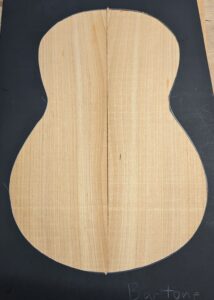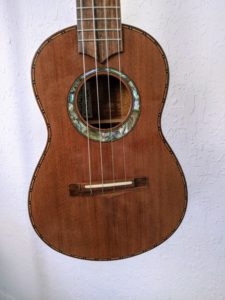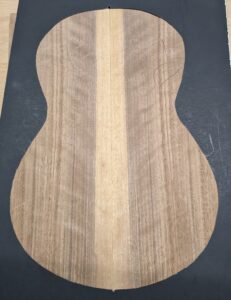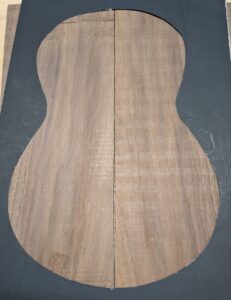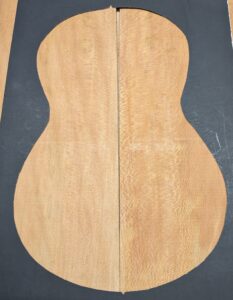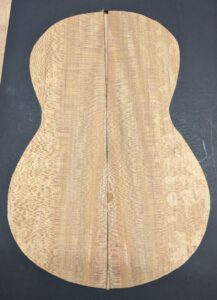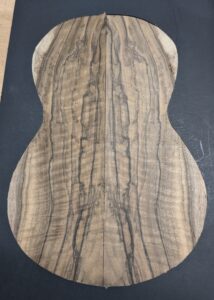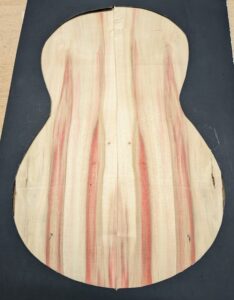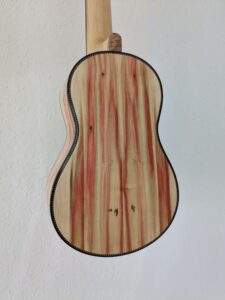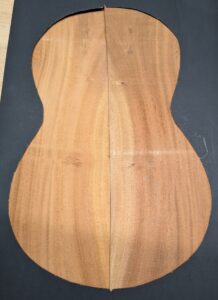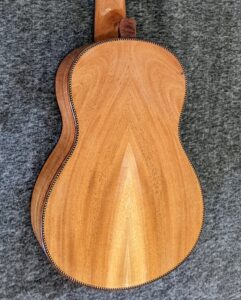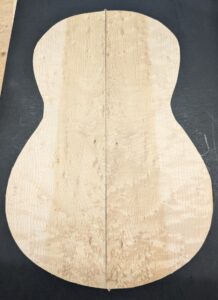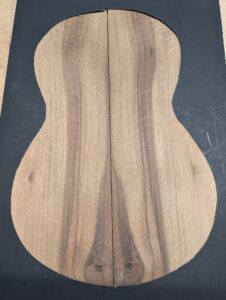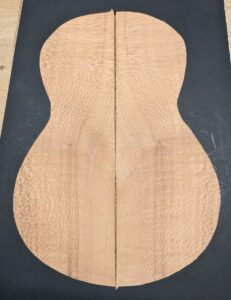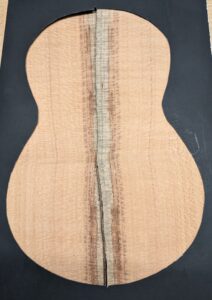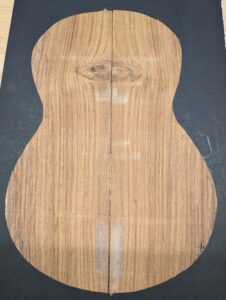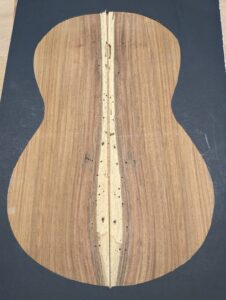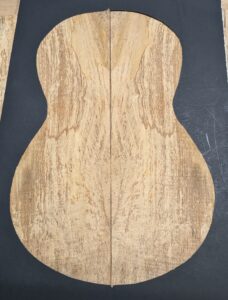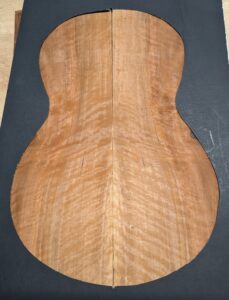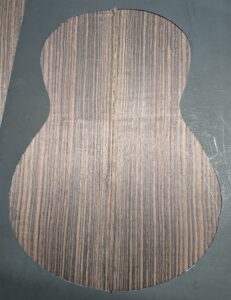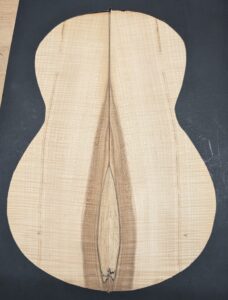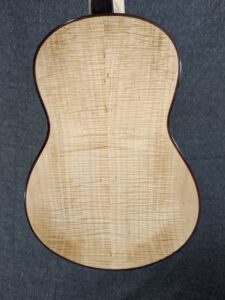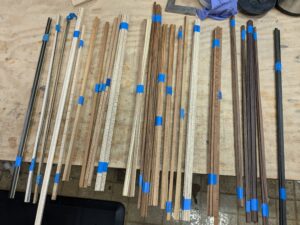This page is intended to show some of the possibilities for wood that can go into a ukulele. These are woods that will make up to a baritone sized ukulele, there are some other options if one wants a tenor sized, or smaller, instrument. These are rough pictures, with the two halves of the bookmatched back just next to each other or overlapped to give a sense of what it will look like. Remember, the color is much richer and a bit darker under finish. The pictures below are samples, when one gets to ordering an instrument, a specific set of wood will be selected.
Since most of woods are harvested by me they are all the same cost wise. There aresome for which I must institute and up-charge because they are scarce/expensive to me.
Top
The top is the most critical part of an instrument. The top makes the sound, the back and side woods contribute rather little. The list below is ordered by ‘brightness’ of the sound, with the brightest being sitka spruce, the first.
Sitka Spruce – (Picea sitchensis) The standard guitar top wood, bright sound, even light cream color.
European spruce, aka German Spruce, (Picea abies) – light cream color, similar to sitka spruce in brightness, the wood I have was harvested by me locally.
Port Orford Cedar (Chamaecyparis lawsoniana) – warmer than the spruces. Port Orford has a nice clear ‘bell like’ tone, great for the finger pickers. Cream colored, some times with a little darker streaking.
Aromatic cedar (Juniperus virginiana) – This is the cedar used to make moth-proof closets and chests. It tends to have some light streaky sections and have a light sapwood which can be put in the center as a light band. The color ages to a warm caramel.
Pennsylvania Red Cedar – I believe that this is the western red cedar (Thuja plicata) that was planted in Pennsylvania as a landscape tree. Light pink color, warm tone.
Redwood – (Sequoia sempervirens) Redwood has the warmest tone of any of the top woods and is good for those playing a low-G tuning. My redwood is recycled from old water tanks that used to be on the top of apartment buildings in New York City. Pink to dark pink in color. The tanks were banded with iron bands, and with the water soaking out and evaporating it can leave a regions of black streaks or darker grey sections.
Back and Sides
The back and side woods are mostly there for looks. Luthiers who I respect say that the back and sides contribute maybe 10% – 15% of the sound. Indeed people have built paper mache and cardboard back & side guitars and they sound fine. So here we are looking for what is pleasing to you eye, or perhaps has a story which resonates. Most of the woods below started with me and a chain saw, or rough lumber from a local sawmill. Most have a story if you want to hear it. In no particular order:
Black Walnut – This can have a lighter sapwood which can be laid up as a center stripe, or it can be without a stripe. Some is curly, some I have is very old, probably cut in the late 1700’s. Lots of different black walnut choices.
Sycamore – sycamore, when cut just right, has a very strong medulary ray pattern.
Caramel sycamore – I like sycamore and have cut it from a number of trees. One tree yielded this caramel colored wood.
Spalted sycamore – this is sycamore with a more yellow color and some lighter banding
English walnut – this was grown in Denver Pennsylvania
Box Elder – box elder gets the red streaking which can be pretty dramatic, not for the faint of heart.
Cuban mahogany – more properly ‘West Indian Mahogany’ – this was the true mahogany before the cut it all down across Cuba and the Caribbean. It does grow all over south Florida. This is from a big tree taken down in my neighborhood.
Birds Eye Maple – this is northern hard maple with the birds eye figure
Quilted maple – this is big leaf maple from the Pacific Northwest. Dramatic figure but it has become quite expensive. What I have I have traded for with a friend on the west coast. The picture shows a section wetted with a little alcohol to show the figure. $75 up-charge.
Casuarina – This is an invasive tree in south Florida. It is very hard and heavy, comparable to an ebony. There are two species, ‘glauca’ which tends to be streaky and equisetifilia which is more evenly dark.
Southern Silky Oak – (Grevillea robusta) A nice pink wood with a lot of chatoyance and medulary ray streaking. Not an oak, that is just the common name. It has a gray sapwood which can be made up as a center stripe or not.
North Indian Rosewood – (Dalbergia sissoo) this tree has been planted all over south Florida. It is a true rosewood. The light colored sapwood, with black filled bug holes can be use as a center stripe, or it can be done without the stripe.
Mango – this is some slightly spalted wood I cut from some big mango trees a local grower was cleaning out.
Carrot Wood (Cupaniopsis anacardioides) – this is a landscape tree planted all over south Florida. It is rather invasive as it makes berries that the birds spread around. Rarely gets very big but my neighbor took down a big one (biggest I’ve seen) and the tree guys were nice enough to bring a chunk across the street to my place. Quite hard and heavy and has a nice curl.
East Indian Rosewood – This is the classic guitar wood, and indeed this was purchased from Martin Guitar. $50 up-charge
Curly maple – this is some maple with a very fine even curl and some darker, slightly spalted sapwood.
Hawaiian koa – This is lovely wood that has become extremely expensive. The wood I have has a nice curl. I brought it back from my honeymoon in Hawaii in 1981 (airline baggage was free). $200 up-charge.
Binding
I cut my own binding wood so the choices are somewhat numerous and change with the times. Here is a picture of some bindings.
The choices from right to left are:
Black bog oak
East Indian rosewood – a couple of shades from more brown to more purple
Quuilted sapele – brown with a quilt figure
koa – in a number of shades, from white to golden to golden-brown. Some with curl, some with white/brown in the same piece.
Sycamore – both white and caramel
curly mahogany
cuban mahogany
curly maple – some with a wide curl and some very white with a narrow curl
two types with black-white-black side purfling, koa, curly maple
true ebony with a white-black-white side purfling


